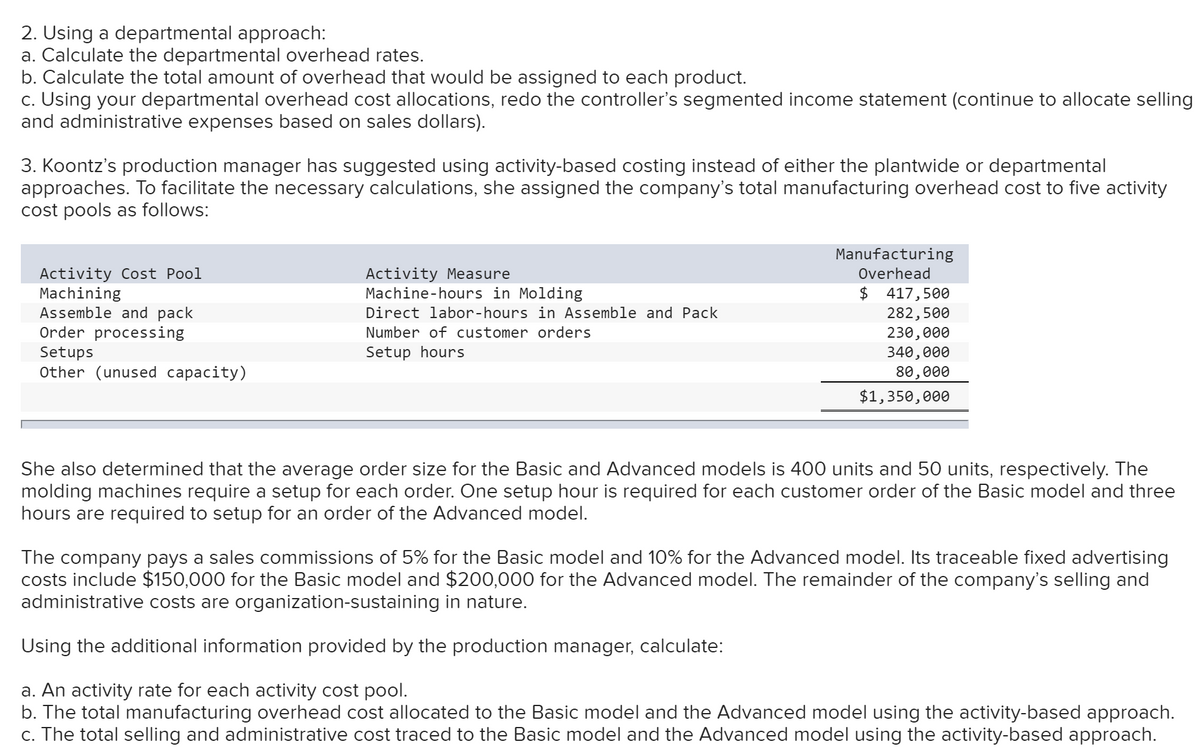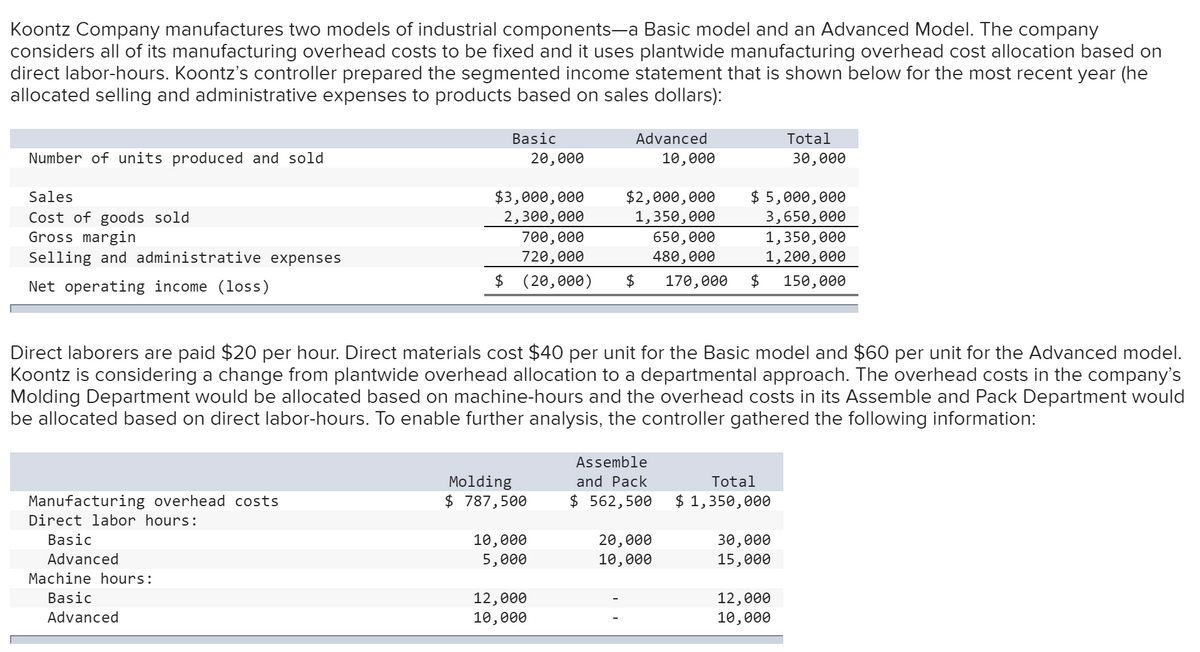Koontz Company manufactures two models of industrial components-a Basic model and an Advanced Model. The company considers all of its manufacturing overhead costs to be fixed and it uses plantwide manufacturing overhead cost allocation based on direct labor-hours. Koontz's controller prepared the segmented income statement that is shown below for the most recent year (he allocated selling and administrative expenses to products based on sales dollars): Basic Advanced Total Number of units produced and sold 20,000 10,000 30,000 Sales $3,000,000 $2,000,000 $ 5,000,000 Cost of goods sold Gross margin Selling and administrative expenses 2,300,000 1,350,000 700,000 720,000 650,000 480,000 3,650,000 1,350,000 1,200,000 Net operating income (loss) $ (20,000) $ 170,000 $ 150, е00
Koontz Company manufactures two models of industrial components-a Basic model and an Advanced Model. The company considers all of its manufacturing overhead costs to be fixed and it uses plantwide manufacturing overhead cost allocation based on direct labor-hours. Koontz's controller prepared the segmented income statement that is shown below for the most recent year (he allocated selling and administrative expenses to products based on sales dollars): Basic Advanced Total Number of units produced and sold 20,000 10,000 30,000 Sales $3,000,000 $2,000,000 $ 5,000,000 Cost of goods sold Gross margin Selling and administrative expenses 2,300,000 1,350,000 700,000 720,000 650,000 480,000 3,650,000 1,350,000 1,200,000 Net operating income (loss) $ (20,000) $ 170,000 $ 150, е00
Chapter5: Process Costing
Section: Chapter Questions
Problem 2PB: The following product costs are available for Kellee Company on the production of eyeglass frames:...
Related questions
Question
I need the answer to 2.B-3.

Transcribed Image Text:2. Using a departmental approach:
a. Calculate the departmental overhead rates.
b. Calculate the total amount of overhead that would be assigned to each product.
c. Using your departmental overhead cost allocations, redo the controller's segmented income statement (continue to allocate selling
and administrative expenses based on sales dollars).
3. Koontz's production manager has suggested using activity-based costing instead of either the plantwide or departmental
approaches. To facilitate the necessary calculations, she assigned the company's total manufacturing overhead cost to five activity
cost pools as follows:
Manufacturing
Activity Measure
hours
Activity Cost Pool
Machining
Assemble and pack
Order processing
Overhead
$ 417,500
282,500
230,000
340, ө0ө
80,000
Molding
Direct labor-hours in Assemble and Pack
Number of customer orders
Setups
Other (unused capacity)
Setup hours
$1,350,000
She also determined that the average order size for the Basic and Advanced models is 400 units and 50 units, respectively. The
molding machines require a setup for each order. One setup hour is required for each customer order of the Basic model and three
hours are required to setup for an order of the Advanced model.
The company pays a sales commissions of 5% for the Basic model and 10% for the Advanced model. Its traceable fixed advertising
costs include $150,000 for the Basic model and $200,000 for the Advanced model. The remainder of the company's selling and
administrative costs are organization-sustaining in nature.
Using the additional information provided by the production manager, calculate:
a. An activity rate for each activity cost pool.
b. The total manufacturing overhead cost allocated to the Basic model and the Advanced model using the activity-based approach.
c. The total selling and administrative cost traced to the Basic model and the Advanced model using the activity-based approach.

Transcribed Image Text:Koontz Company manufactures two models of industrial components-a Basic model and an Advanced Model. The company
considers all of its manufacturing overhead costs to be fixed and it uses plantwide manufacturing overhead cost allocation based on
direct labor-hours. Koontz's controller prepared the segmented income statement that is shown below for the most recent year (he
allocated selling and administrative expenses to products based on sales dollars):
Basic
Advanced
Total
Number of units produced and sold
20,000
10,000
30,000
$3,000,000
2,300,000
700,000
$2,000,000
1,350,000
650,000
480,000
$ 5,000,000
3,650,000
1,350,000
1,200,000
Sales
Cost of goods sold
Gross margin
Selling and administrative expenses
720,000
Net operating income (loss)
$ (20,000)
170,000
150,000
Direct laborers are paid $20 per hour. Direct materials cost $40 per unit for the Basic model and $60 per unit for the Advanced model.
Koontz is considering a change from plantwide overhead allocation to a departmental approach. The overhead costs in the company's
Molding Department would be allocated based on machine-hours and the overhead costs in its Assemble and Pack Department would
be allocated based on direct labor-hours. To enable further analysis, the controller gathered the following information:
Assemble
and Pack
Molding
$ 787,500
Total
Manufacturing overhead costs
Direct labor hours:
$ 562,500
$ 1,350,000
Basic
10,000
5,000
20,000
10,000
30,000
15,000
Advanced
Machine hours:
12,000
10,000
12,000
10,000
Basic
Advanced
Expert Solution
This question has been solved!
Explore an expertly crafted, step-by-step solution for a thorough understanding of key concepts.
This is a popular solution!
Trending now
This is a popular solution!
Step by step
Solved in 3 steps with 7 images

Knowledge Booster
Learn more about
Need a deep-dive on the concept behind this application? Look no further. Learn more about this topic, accounting and related others by exploring similar questions and additional content below.Recommended textbooks for you

Principles of Accounting Volume 2
Accounting
ISBN:
9781947172609
Author:
OpenStax
Publisher:
OpenStax College

Cornerstones of Cost Management (Cornerstones Ser…
Accounting
ISBN:
9781305970663
Author:
Don R. Hansen, Maryanne M. Mowen
Publisher:
Cengage Learning

Managerial Accounting
Accounting
ISBN:
9781337912020
Author:
Carl Warren, Ph.d. Cma William B. Tayler
Publisher:
South-Western College Pub

Principles of Accounting Volume 2
Accounting
ISBN:
9781947172609
Author:
OpenStax
Publisher:
OpenStax College

Cornerstones of Cost Management (Cornerstones Ser…
Accounting
ISBN:
9781305970663
Author:
Don R. Hansen, Maryanne M. Mowen
Publisher:
Cengage Learning

Managerial Accounting
Accounting
ISBN:
9781337912020
Author:
Carl Warren, Ph.d. Cma William B. Tayler
Publisher:
South-Western College Pub

Principles of Cost Accounting
Accounting
ISBN:
9781305087408
Author:
Edward J. Vanderbeck, Maria R. Mitchell
Publisher:
Cengage Learning

Financial And Managerial Accounting
Accounting
ISBN:
9781337902663
Author:
WARREN, Carl S.
Publisher:
Cengage Learning,

Managerial Accounting: The Cornerstone of Busines…
Accounting
ISBN:
9781337115773
Author:
Maryanne M. Mowen, Don R. Hansen, Dan L. Heitger
Publisher:
Cengage Learning